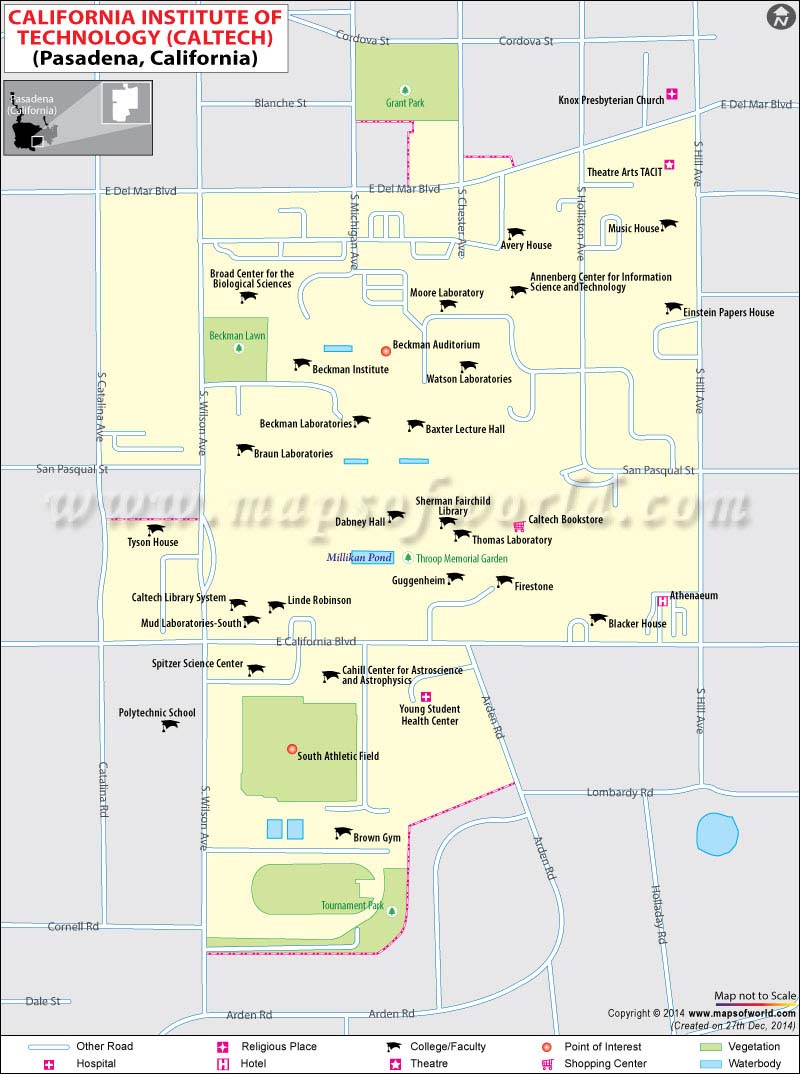About California Institute of Technology

Where is Caltech
Located about 11 miles north of Los Angeles in suburban Pasadena, Caltech offers beautiful weather, nearby beaches, and many outdoor activities. There is plenty to do in the college community around campus, as well as special events, theaters, museums, and other forms of entertainment in Los Angeles. If a student does not have a car, shuttles and forms of public transportation can help them get out into the city.
The location also benefits employment opportunities, especially over the summer, which includes various internships available in the region.
In a Nutshell
California Institute of Technology, usually called Caltech, is another central technology school in the United States. Caltech is a much smaller alternative to MIT and its main rival. A tiny university with a total of 2,231 students, of which less than 1,000 are undergraduate students, Caltech is a private research university located in Pasadena, California. This Southern Californian school follows a quarter system from late September to early June.
Founded in 1891, Caltech has played an essential role in national science research over its history as host to world-famous scholars like Albert Einstein and, more recently, Richard Feynman.
Caltech focuses on providing education that is integrated with research, emphasizing science and technology with an interdisciplinary style of study. Caltech has been rated at the top of worldwide lists for its Engineering and Technology and Physical Science programs. This school works toward advancements in science and technology, especially in regards to finding and developing alternative sources of renewable energy, and health and medicine.
Academic Achievement
Caltech’s strong focus on research has helped make it a top universities in USA, which draws great faculty members and has earned Caltech some federal funding. Research facilities associated with Caltech include four campus research centers like observatories for astronomy, astrophysics, and planetary science programs, and facilities for NASA programs like the Jet Propulsion Laboratory that focuses on robotic exploration of the solar system.
The faculty at Caltech are some of the best in the nation, with a high percentage of professors having won awards for their work, including the Nobel Prize, National Medal of Science, and California scientist of the year. Caltech boasts the best student to faculty ratio of any research university in the country, at three students per faculty member, giving students many opportunities to work closely with their professors and advisers.
About 64 percent of classes at Caltech are smaller than twenty students, and only about 3 percent have more than one hundred students enrolled. The academic divisions at Caltech are Biology, Chemistry and Chemical Engineering, Engineering and Applied Science, Geological and Planetary Science, Humanities and Social Sciences and Physics, Mathematics, and Astronomy. Within these divisions are a wide variety of courses of study. Frontier courses are an unusual course offering, in which faculty visit classrooms to discuss their research progress with the students.
One of Caltech’s research programs is called SURF, or Summer Undergraduate Research Fellowships, which provides grants to students that allow them to spend their summers learning and researching in a hands-on environment.
Bang For Your Buck
Caltech follows a need-blind admissions process, and strives to meet 100% of students needs with grants and financial aid. Tuition is about $35,000 annually, and the average scholarship is about $31,000. About 53 to 58 percent of students receive financial assistance. The average debt a student carries after four years at Caltech is about $10,000.
With the research opportunities available to Techers, the small class sizes and top faculty, Caltech can be a great option for students in terms of both education and costs.
Social Scene
Students at Caltech can live in one of the eight student houses, which each have their own character and charm. The original four houses were built in 1931 and are modeled after Oxford University’s student housing. The following three were built in the 1960s, and the last was built in 1996.
The houses serve as a social community, and have seated dinners with housemates, parties, and other events that create a tight-knit group. When freshmen arrive at Caltech, they get to visit the houses and experience each of their cultures at dinners and social events, before making the decision of where to live. Freshmen are required to live on campus for their first year, and after that they may move off campus, but most students choose to continue living on campus.
There are over 150 diverse clubs and organizations at Caltech, despite the small number of students. Caltech participates in both intercollegiate and club sports. The student population is about 60 percent male and 40 percent female.
Why Caltech Made Our List
Caltech is a great research university that provides an alternative to MIT with comparable programs and faculty members. There are many differences between the schools, culturally and academically, but one of the biggest differences between the schools is their size. Caltech is about a fifth of the size of MIT, providing a very different college experience. The preference between these schools depends entirely on the individual student, and prospective students should visit schools before they choose.
With such an abundance of Northeastern schools on our list, a balance of West Coast schools provide great geographic alternatives, in addition to the differences in culture, weather, and specific programs.
